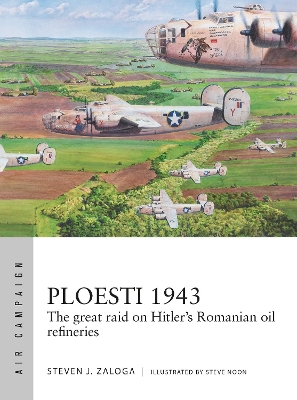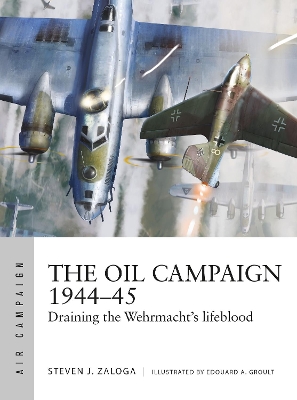Air Campaign
3 total works
In mid-1943, Allied intelligence began to pick up the signs of unusual German construction in remote locations near the Channel Coast. Several massive fortifications were beginning to take shape, and they appeared to be oriented towards London. Allied intelligence codenamed these sites as "Crossbow" and began plans to attack them before they could bombard Britain's capital city. These "Heavy Crossbow" sites for the V-1 and V-2 missiles were supposed to be bomb-proof, but they soon attracted the attention of RAF heavy bombers with the new Tallboy concrete-penetrating bombs.
Fully illustrated with commissioned artwork and contemporary photographs, Operation Crossbow 1944 examines the dynamics of the world's first missile war. It also describes the parallel American efforts to develop missiles and assault drones to attack the "Heavy Crossbow" sites, including the Air Force's Aphrodite and Navy Anvil projects.
Fully illustrated with commissioned artwork and contemporary photographs, Operation Crossbow 1944 examines the dynamics of the world's first missile war. It also describes the parallel American efforts to develop missiles and assault drones to attack the "Heavy Crossbow" sites, including the Air Force's Aphrodite and Navy Anvil projects.
Operation Tidal Wave was one of the boldest and most controversial air raids by the United States Army Air Forces (USAAF). At the time, the Romanian Ploesti oil fields produced about a third of all Axis oil, and was Germany's single most important fuel source. In the summer of 1943, the USAAF decided to stage a major raid on Ploesti from air bases in Libya. The resulting Operation Tidal Wave raid on 1 August 1943 was one of the costliest to date, losing 53 aircraft, about a third of the starting force. Of the more than 150 bombers that took part in the raid, only 88 B-24s returned to Libya, 55 of which were damaged. On the other hand, of the 17 Medals of Honor awarded to US soldiers and airmen from Pearl Harbor in 1941 to D-Day in 1944, 5 were awarded to pilots of the Tidal Wave mission in recognition of their extraordinary performance. Although undoubtedly bold and heroic, the mission had questionable results. Initial assessments argued that the mission caused 40% of the refinery capacity at Ploesti to be lost but subsequent studies concluded that the damage was quickly repaired and that output had exceeded August levels within a month.
This new study examines the raid in detail, exploring the reasons why its dubious success came at such a high price. Supported by maps, diagrams, and full-colour artwork including battlescenes and bird's-eye views, this is the full story of the audacious Ploesti raid of 1943.
This new study examines the raid in detail, exploring the reasons why its dubious success came at such a high price. Supported by maps, diagrams, and full-colour artwork including battlescenes and bird's-eye views, this is the full story of the audacious Ploesti raid of 1943.
A new illustrated history of one of the key air campaigns of late World War II – the American effort to cripple Germany's oil production, and grind its armed forces to a halt.
With retreating German forces losing their oilfields on the Eastern Front, Germany was reliant on its own facilities, particularly for producing synthetic oil from coal. However, these were within range of the increasingly mighty Allied air forces. In 1944 the head of the US Strategic Air Forces, General Carl Spaatz was intent on a new campaign that aimed to cripple the German war machine by depriving it of fuel.
The USAAF’s Oil Campaign built up momentum during the summer of 1944 and targeted these refineries and plants with its daylight heavy bombers. Decrypted German communications made it clear that the Oil Campaign was having an effect against the Wehrmacht. Fuel shortages in the autumn of 1944 forced the Luftwaffe to ground most of its combat units except for fighters involved in the defense of the Reich. Fuel shortages also forced the Kriegsmarine to place most of its warships in harbor except for the U-boats and greatly hampered German army campaigns such as the Battle of the Bulge in December 1944–45.
This fascinating book packed with key photos and illustrations examines the controversies and debates over the focus of the US bombing campaign in the final year of the war, and the impact it had on the war effort overall.
With retreating German forces losing their oilfields on the Eastern Front, Germany was reliant on its own facilities, particularly for producing synthetic oil from coal. However, these were within range of the increasingly mighty Allied air forces. In 1944 the head of the US Strategic Air Forces, General Carl Spaatz was intent on a new campaign that aimed to cripple the German war machine by depriving it of fuel.
The USAAF’s Oil Campaign built up momentum during the summer of 1944 and targeted these refineries and plants with its daylight heavy bombers. Decrypted German communications made it clear that the Oil Campaign was having an effect against the Wehrmacht. Fuel shortages in the autumn of 1944 forced the Luftwaffe to ground most of its combat units except for fighters involved in the defense of the Reich. Fuel shortages also forced the Kriegsmarine to place most of its warships in harbor except for the U-boats and greatly hampered German army campaigns such as the Battle of the Bulge in December 1944–45.
This fascinating book packed with key photos and illustrations examines the controversies and debates over the focus of the US bombing campaign in the final year of the war, and the impact it had on the war effort overall.


